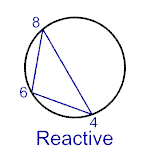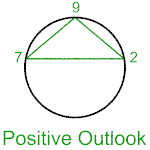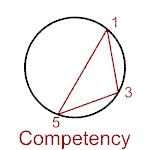There are three Harmonic approaches:



The Harmonic patterns of the Enneagram tell us how each type reacts when they don't get what they want. This reaction includes their response to stress, crisis, and conflict.
When we are in conflict with another person, our personality structures often get in the way. We become frustrated because the other person doesn't see things the same way we do. By not communicating at the same level, we are unable to agree on the scope and importance of the problem. Furthermore we may disagree on the method to resolve it.
The following tables list each combination of harmonic groups. For each combination, we list the reaction of each person to the conflict and some of the issues that arise because of the two parties operating on the same (or different) level. Furthermore, we list suggestions to better connect with the other party in the dispute to resolve it.
There are three Harmonic approaches:



 vs.
vs.

Agreement that there is no problem or that it really isn't worth arguing. “Problem? What problem?”
Remind yourselves that the problem won’t go away by itself. You must acknowledge the problem and resolve it. Things will be better once the problem has been dealt with. If dealing with the problem is overwhelming, be committed to at least spending short amounts of time on it.
 vs.
vs.

Both you and the other person agree that this is a big deal. Both of you react emotionally and feel that the other person understands the importance of the problem. Feel better after venting. Mutual catharsis. May build off each other’s worry and catastrophize. “This is terrible! What are we going to do?” “There’s nothing we can do, this is terrible!”
Remind yourselves that the conflict or problem is not the end of the world. Venting and resolving your feelings doesn’t address the root cause of the problem Remind yourselves to address the problem rather than just worrying about it.
 vs.
vs.

Agreement that we can find a logical solution. There may be further (but civilized) disagreement about the right method in which to solve the problem. Neither of us gets emotional about the problem – we dispassionately find the most efficient and practical method for solving it.
“OK, we’re both adults, let’s solve this problem. Get out the clipboard and checklist.”
Remember that rules and logic alone can’t solve all the world’s problems. Consider the feelings of others and the human impact of your solutions. You can’t solve emotional problems in purely rational and logical manner. It’s important to deal with the emotional content of your problems.
 |
vs. |
 |
Reaction to Conflict |
||
[Reactive] |
[Positive Outlook] The other person just keeps repeating how bad the situation is. They are overly-pessimistic. It seems they won’t be happy until they’ve made me upset. “I don’t think this is such a big deal.” “Isn’t it a beautiful day outside?” |
|
Conflict Resolution Strategies |
||
[Reactive] |
[Positive Outlook] |
|
 |
vs. |
 |
Reaction to Conflict |
||
[Positive Outlook] |
[Competency] I have a problem-solving approach and strategy all set up, but the other person doesn’t want to solve this problem. Sometimes, I think the other person doesn’t even believe there is a problem to fix. “OK, let’s look at the problem, focus on it, and solve it.” |
|
Conflict Resolution Strategies |
||
[Positive Outlook] |
[Competency] |
|
 |
vs. |
 |
Reaction to Conflict |
||
[Reactive] |
[Competency] The other person is overreacting – they get overly emotional and pessimistic. The other person frustrates me because s/he keeps focusing on how bad the problem is without wanting to fix it. I’m trying to resolve this problem, but s/he is stuck dwelling on it. “Yes, I know there’s a problem, I’m trying to solve it.” |
|
Conflict Resolution Strategies |
||
[Reactive] |
[Competency] |
|